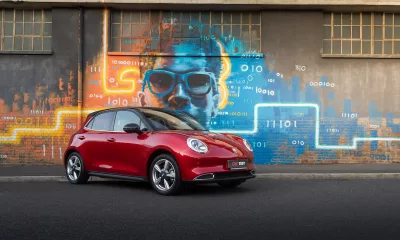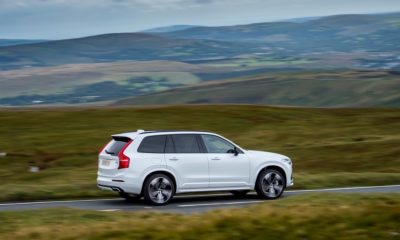BACK in the late-1960s, one of the fanciest executive cars you could aspire to own was the Dodge Monaco. Unlike our test vehicle, the Dodge Journey, with its V6 engine and front-wheel drive, the Monaco sported a V8 engine and rear-wheel drive. We do notice at least one similarity, though – they can both seat up to seven people. But, whereas the limousine from the ’60s used two bench seats to achieve this, the latest from the ramemblem stable uses three rows of individual seats. It is dubbed a cross-over vehicle, somewhat MPV, somewhat SUV. American cars don’t always offer the appeal that European stylists manage to accomplish, but the Dodge family presents some interesting designs. The Journey is a good looker for a large people conveyer, especially in the test car’s “inferno red” livery although, as always, there were mixed emotions from our team. The big chromed grille is typical Dodge fare, and the flared wheelarches add to the appeal. This test involves the 2,7-litre V6 model – there is also a 103 kW 2,0-litre diesel-engined version – which has 136 kW at 5 500 r/min and 256 N.m of torque at 4 000 r/min. The engine is transversely mounted and, surprisingly for such a layout, leaves lots of under-bonnet space for servicing access, a very rare sight these days. Our test unit was the R/T version that includes leather rather than cloth upholstery, and two extra inches on the wheels, up from 17 to 19 inches in diameter. This does come at a price though, some R30 000 more than the SXT model.
The leather-trimmed seats look ostentatious in their two-tone colour scheme (different combinations are offered) but are rather flat, not providing much support. The driver’s seat has electric fore/aft adjustment, but uses a lever for height, lumbar support and backrest rake. The steering wheel adjusts for reach as well as height. Leg- and foot room are also acceptable, better than most Jeep models, and headroom is plentiful. Interior and exterior door handles are chrome plated. Roof rails also have a chrome finish.
Many cars, especially of American origin, like to warn you about all sorts of things with “bings” and “bongs”. This can be very annoying yet, oddly, the Journey does so when you leave the key in the ignition and open the driver’s door, but not if you fail to put on your seatbelt – when you are faced with a flashing light for a few seconds. Two gloveboxes are provided ahead of the front passenger seat. The upper one has a rubber bracket for holding two drink cans that can be kept cool via the air-conditioner. The front passenger seat cushion can be flipped up to reveal a storage compartment that is quite deep, and more storage room can be found in the footwells of the middle row in the form of a pair of underfloor compartments that are spacious enough for a couple of cameras or a shopping bag. Alternatively, you could keep food or drinks cool, since a deep waterproof plastic tray can be partially filled with ice and removed later for cleaning. Very neat!
Two other useful features are the flip-down mirror that allows the driver to keep an eye on what is happening in the back, and a rechargeable torch, flushmounted into the left-hand luggage area behind the last row of seats.
Auxiliary audio controls are situated behind the steering wheel rim, their functions quickly understood and requiring very little finger movement to operate, with buttons on the front activating the display menu, which includes trip information. One button has the sole function of displaying the compass and outside temperature, but cannot be pushed twice to return to the previous information – another button must be used for this. Luckily, the Dodge has conventional sun visors that you pull towards yourself to release, unlike some Jeep models that require you to push the sun visor away from you first, then drop it slightly and pull it back to swivel. Air vents are neatly designed and have a classy finish.
An important entertainment feature (optional, mind you), is the MyGig system, available for R16 900. This consists of GPS navigation with touch screen, voice command, a 30-gigabyte hard drive, and a six-CD/DVD front loader fitted to the excellent Infinity audio system. An auxiliary input and USB port are provided as well. A rear-view camera also forms part of this package. This system has its controls at the lower end of the hangdown section of the facia and really looks business-like, although the myriad buttons and knobs take a while to master. These are all of good quality, however. A rear seat video entertainment system is available. This costs R15 000 and includes a console-mounted DVD player with two headsets and auxiliary input jacks. Luggage space is reasonable, with even a respectable 112 dm3 available when all seven seats are in use. This expands to 392 dm3 with the rearmost seats collapsed, and measures a spacious 1 390 dm3 with only the front seats in use. A cargo net is supplied plus a cloth screen that acts as a flexible, hook-on parcel shelf to hide your shopping. The front passenger seat backrest can also be collapsed forwards to allow longer objects to be carried. A clever mechanism allows the middle row of seats (split 60:40) to be slid forwards while the cushion rises to increase the travel. This gives fairly easy access to the last two seats. Dual-zone climate control takes care of front seat occupants, and an overhead panel above the centre row gives the rest of your clan the option of adjusting their own temperature, fan speed and air distribution via four roof-mounted vents that can be individually angled or closed in addition to foot-level vents. Each door has a pocket with space for a water bottle, and the last two seats have armrests with incorporated drinkholders, so you have to choose between resting your arm or your drinks. Yet more features include heated front seats, an auto-dimming rear view mirror, folding side mirrors and a tyre pressure monitoring system. Dual 12v outlets are supplied in the lower facia section with another in the centre and yet another at the rear. Our test unit had a dodgy car alarm that kept going off and annoying anyone within earshot, so we had to leave the car permanently unlocked. Under the rear floor, a storage compartment houses the tyre changing equipment and leaves enough hiding space for quite a few items. The space-saver spare wheel frees up volume needed by the extra row of seats. We had occasion to use this due to a cut in the sidewall of a rear tyre, and wouldn’t like to travel too far with it, since it looks puny next to the massive 19-inch road wheels.
The engine is rather noisy at low speeds due to belt whine, but this is only noticeable outside the car. Inside, noise levels are quite low at all speeds.
Performance is adequate for the size of vehicle, with a top speed of 182 km/h and a 0-to-100 km/h time of 11,1 seconds. Top speed was achieved with the gearbox just making the shift from fourth into fifth gear at 6 400 r/min, the revs dropping to 4 500. This shows the extent of overdrive gearing provided in top gear. At 120 km/h in sixth, the engine is turning over at only 2 000 r/min. Gear changes are smooth and fairly rapid for a conventional gearbox, but there is quite a bit of slip in the initial pullaway, which hampers progress for a moment. Six ratios mean that the transmission struggles to decide which gear to select: it can drop up to three gears in succession for overtaking acceleration. Fuel consumption is unexceptional, with an index figure of 12,36 litres/100 km, so employing a light right foot will help save money and oil reserves. A large fuel tank of 78 litres provides a holiday friendly range of just over 600 km.
Although the steering has a slightly remote feeling, it shouldn’t annoy most drivers, and the ride is soft and leisurely, which is fit for the purpose.
Long journeys should be very satisfying in this vehicle. Razorsharp handling might not be its forté, but we don’t foresee any owners upsetting their passengers by leaning it briskly into corners at speed anyway.







